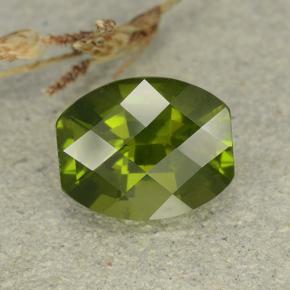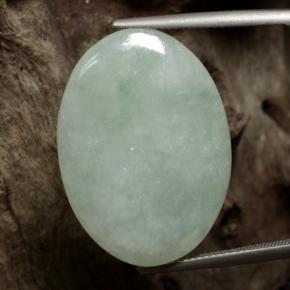Idocrase Gemstone Information

About Idocrase - History and Introduction
Idocrase is a rare gemstone, usually found in shades of green and sometimes yellow-brown or pale blue. It belongs to the silicate group of minerals, defined specifically as a calcium-aluminum-silicate. In most cases, the name 'idocrase' is used when referring to the gemstone form, while 'vesuvianite' is used more in reference to its rough crystal form. The name 'vesuvianite' was derived from Mt. Vesuvius, the name of the volcano of where idocrase was first discovered.
The name 'idocrase' comes from the Greek words 'eidos' and 'krausis' which respectively translate as 'form' and 'mixture'; in reference to its crystals, which often exhibit a mixture of other mineral forms. Idocrase was first identified in 1795 by renowned German gemologist, Abraham Gottlob Werner. Werner was also the first to discover chrysoberyl, another very important gemstone and mineral group most famous for its cat's eye and rare color-change variety. Werner was also the mentor of Friedrich Mohs, the creator of the 'Mohs scale of hardness' which is still the definitive scale used today.
Identifying Idocrase
Gemologically, idocrase is a complex mix of metals, oxygen, hydrogen and fluoride, which is classified as a calcium aluminum silicate. Its specific gravity ranges from 3.32 to 3.47, approximately the same as tanzanite. Idocrase has a refractive index of 1.700 to 1.723, slightly lower than spinel and garnet. It is slightly softer than quartz, rating 6.5 on the Mohs scale of hardness. Idocrase crystals form in a tetragonal structure. Massive forms are common and it can often be very difficult to distinguish from grossular garnet. However, grossular garnet is much harder and its crystals are true dodecahedral crystals rather than tetragonal crystals.
Idocrase Origin and Sources
Idocrase or vesuvianite is found in a number of locations in the world. It is known to form in skarn (silicate gangue or waste rock) and limestone deposits through the geological process of contact metamorphism. Some of the most notable gem-quality deposits come from Quebec, Canada and Mt. Vesuvius in Italy. Other notable sources include the Ural Mountains of Russia as well as China, Norway, Pakistan, Sweden, Switzerland, Kenya, Tanzania and the United States (California, Arkansas, Maine, Vermont and New Hampshire).
The more recent finds of Kenyan and Tanzanian materials have brought some very nice transparent gem quality stones to the market, albeit in very limited quantities. California (USA) produces a green cabochon grade material often marketed as 'Californite' or by the misleading name 'California jade' (owing to its strong resemblance to jade). The Jeffrey Mine in Quebec, Canada produces a fine facetable, yellow-green material, as well as a chromium-rich emerald-green variety and an extremely rare, violet to lilac colored variety of idocrase.
Buying Idocrase
Idocrase Color
Almost all idocrase occurs in a shade of green, ranging from dark green to green-brown and yellow-green to olive green. Some very rare materials can form with a pale blue or lilac color. Many stones can occur bicolored, and they may also form multicolored with random spotting and streaking of reddish brown, white, yellow or blue colored material.
Idocrase Clarity and Luster
Most gem-quality idocrase occurs opaque with an appearance similar to that of jade. Transparent and translucent forms of idocrase are quite rare. Opaque idocrase exhibits a greasy or resinous luster, while transparent to translucent materials exhibit a glass-like (vitreous) luster.
Idocrase Cut and Shape
Most transparent gem-quality idocrase is faceted, often with a checkerboard cut. The most popular shapes include round, marquise, octagon (emerald) cut, trillion, oval, cushion and pear. Idocrase is often carved into ornamental objects, especially idocrase that is heavily included with grossular garnet (referred to as grossular vesuvianite).
Idocrase Treatment
Idocrase is not known to be treated or enhanced in any way. It is one of the few gemstones which remains completely untreated from the mine to the market.
Idocrase Gemological Properties
Chemical Formula: Ca10Mg2Al4(SiO4)5(Si2O7)2(OH)4 - Complex calcium aluminum silicate
Crystal Structure: Tetragonal; thick columnar crystals
Color: Green, olive-green, yellow-brown, pale blue
Hardness: 6.5 on the Mohs scale
Refractive Index: 1.700 to 1.723
Density: 3.32 to 3.47
Cleavage: Indistinct
Transparency: Transparent, translucent, opaque
Double Refraction 0.002 to -0.012
Luster: Vitreous to resinous
Fluorescence: None
Please refer to our Gemstone Glossary for details of gemology-related terms.
Idocrase: Similar Gemstone
Jadeite Cabochon

Jadeite
Idocrase is very popular among collectors, but lesser known by mainstream jewelers. There are no other closely related gemstones in regard to chemical make-up and crystal structure, but there are a few varieties of idocrase itself. A massive compact form resembling jade is referred to as 'californite' or 'California jade'. Chromium-rich idocrase is known as 'chrome vesuvianite' and a rare blue variety is known as 'cyprine'. 'Mangan vesuvianite' is a reddish to purple variety of manganese-rich idocrase and 'wiluite' is a boran-rich idocrase, but nowadays, wiluite is considered to be its own distinct mineral species.
Some common mineral associations include grossular garnet, calcite, zoisite, serpentine and diopside. There are also a variety of gems which can be easily mistaken for idocrase, including jade, zircon, tourmaline, peridot and garnet.
Idocrase - Metaphysical and Crystal Healing Properties
In the world of metaphysical gems, idocrase is more often referred to as vesuvianite. It is an astrological gemstone associated with the signs of Sagittarius and Capricorn. It is believed to help clear negative energy, including thoughts, anger, depression and fear. Idocrase is said to give its wearer strength, courage and a sense of self-security. Idocrase is highly recommended for newly married couples as well as business partners and associates, since it represents a cooperative effort. Idocrase is believed to help the heart chakra with spiritual strength. Physically, it is thought to alleviate skin disorders, prevent malnutrition and strengthen teeth and bones. Depending on the color of idocrase, other metaphysical properties may also be enhanced.
Disclaimer: Metaphysical and Alternative Crystal Healing Powers and Properties are not to be taken as confirmed advice. Traditional, Ceremonial and Mythological Gemstone Lore is collected from various resources and is not the sole opinion of SETT Co., Ltd. This information is not to replace the advice of your doctor. Should you have any medical conditions, please see a licensed medical practitioner. GemSelect does not guarantee any claims or statements of healing or astrological birthstone powers and cannot be held liable under any circumstances.
Idocrase Jewelry Ideas
Idocrase is considered to be fairly hard and quite durable. It is perfectly suitable for nearly all jewelry designs, including rings, although rings containing idocrase should be worn with extra care. Since it is slightly softer than quartz, the safest designs include earrings, pendants, bracelets and necklaces. As a zodiacal stone for Sagittarius and Capricorn, it is often found in astrological birthstone jewelry. In the jewelry trade, idocrase is not often referred to as vesuvianite, but when used for crystal healing, vesuvianite seems to be the preferential term.
Note: Buy colored gemstones by size and not by carat weight. Colored stones vary in size-to-weight ratio. Some stones are larger and others are smaller than diamond by weight in comparison.
Idocrase Gemstone and Jewelry Cleaning and Care
How to clean your gemstonesIdocrase is slightly softer than quartz, but it lacks cleavage, making it quite durable. When cleaning, use warm water and a mild soap or detergent. Wipe down your stones using only a soft cloth or brush. Be sure to rinse well to remove any soapy residue. As with most gemstones, it is best to avoid the use of ultrasonic cleaners and steamers. Do not use any harsh chemicals or cleaning fluids, including bleach, ammonia and acid. Take extra care when spraying perfume or hairspray as these chemicals can cause erosion. Avoid extreme temperature fluctuations and prolonged exposure to heat or light to prevent damage to the color of your stones.
Always remove gems and jewelry before playing sports, exercising or engaging in any vigorous household chores, such as dish-washing. Avoid contact with other gems to prevent scratches and fractures and when storing your gems, store them separately and away from other gems. It is recommended that you always wrap your gems in a soft cloth and place them inside a fabric-lined jewelry box.
출처 : https://www.gemselect.com/gem-info/idocrase/idocrase.php